The Roman Legion
The military history in Rome is identified traditionally with its legions. This is not completely exact because many other were the specific factors that contributed to its greatness: the war power founded on a wise use of the militia provincialis (provincial army), of the mercenary strengths, of a high-class engineering and of a warlike culture firmly maintained long live from the dominant elite politically. However never any other army, ancient or modern, it had similar soldiers: at times turbulent and dissatisfied, other tool of their heads, but always formidable fighters and not for limited time but for centuries. For centuries the legions, always limited in the number, were used for maintaining the Roman supremacy, thanks to a hard discipline, a training minute and able commanders.
The decadence of the empire was accelerated when the legions stopped existing as fighting entity, in fact until they were mails in degree to face the enemy, they always won the wars. After all it can reasonably affirm that when the soldiers illirici or pannonici disappeared from the scenery of the battles, to be replaced from Barbaric, or when the heavy infantry had to surrender its role prince to turmae of African or oriental riders, then really it began the definitive decline, the point of no return, for the military power in Rome.
The Origins^
The life of the legions begins with the birth of Rome (around 753 BC) the term legio ('levy', basic Roman military unit of several thousand men indicated) that city-soldier that they took the weapons to the call of their king. The contingent that formed the legion were based on the tribes (three in the period of the kings: Ramnes, Tities, Luceres), each of which it furnished, 1000 infantrymen and 100 riders, so that the legion was composed from 300 riders and 3000 infantrymen.
The legion, commanded by the king, it was dismissed at the end of the conflict, to its orders they were the tribuni militum (senior legionary officer), one for every contingent of infantry furnished, and the tribuni celerum for the squadrons of cavalry. Nobility probably fought in the first lines of the line up, because better army and equipped.
The armament had to be typical of the epoch: caress, helmet, wood shield, strengthened by elements of metal and the sword. The line up, in battle, it happened with a compact front, infantrymen to the center and cavalry on the wings, with the most able fighters and better armed in the first files, in front of all the velites (soldiers armed with lances, that cast against the enemy).
Servio Tullio's Reform^
Servio Tullio (578-534 BC) made the first reform of the arrangement of the army, contemporary to that social, the population was divided in five classes according to the income (estate) every class in centuria ('hundred'; military unit of some thirty to two hundred foot soldiers), for a total of 193, each of which it had to furnish 100 valid men to the army.
In the first class there were the citizens with greater estate, that had therefore a greater number of centurie and it also furnished the contingent of cavalry. The rest of the militia was furnished by the remainders classes. The arrangement of the legion had for base the decuria (from ten to thirty horse men in the legion of the early republic) and the centuria, while the cavalry was separated in turma (cavalry unit = three decurie). The formation was analogous to the preceding one, 3000 men on six lines of depth and 500 files of forehead.
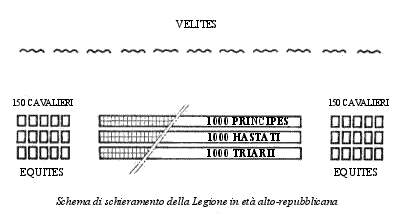 Falangitica Legion in epoch Serviana
Falangitica Legion in epoch ServianaThey completed the organic unity of fabri (artisans), cornicines (horn-blowers), tubicines (trumpeters) and of rorarii ('attackers'; legionary skirmisher attached to units of triarii) , kind of light infantry. The citizens with an inferior income to the 11.000 aces were reunited in an only class and they were exempted by to lend military service.
A further subdivision between juniores and seniores intervened later, the first ones formed the army of line while the seconds, men among the 45 and the 60 years, constituted the departments of the backup army. The strength of a legionaria unit was of around 4200 infantrymen and 300 riders.
This type of formation had sure advantages, it was a monolithic complex that hardly it arrested once in movement and that it crushed the enemy, but it also had evident defects, it missed of flexibility and of maneuverability and subsequently as tactical formation was abandoned.
Then was born the manipulus ('handfull': (1) unit consisting of two centuriae; (2) late Roman army squad) for the necessity to have more mobile departments and able to act with more elasticities.
The 10 manipuli of hastati ('spearmen'; legionary heavy infantryman), the more young people, were set in first line, therefore it followed others 10 manipuli of principes ('leaders'; legionary heavy infantry soldier) and finally as many manipuli of triarii ('third liner'; heavy legionary infantry soldier), the veterans,: if hastati and principes counted 120 men for every unity, every manipuli of triarii were formed only from 60 fighters, while the cavalry was separated in decurie and turme. The light infantry, the velites, were not framed in organic unity but it were able to fight both autonomously in some tactical phases, that mixed to the departments of heavy infantry.
The manipuli will form the base of the Roman legion, while it is changing the disposition on the field of the single fighters. It won't be the estate anymore to decide the place among the lines of the manipuli, but also the age of the soldiers will be considered determinant. An unity of this kind counted 4500 men besides the usual contingent of riders. With legions so composed Rome practically conquered the whole Italy.
|
1 centuria |
= |
10 manipoli
|
hastati
|
= |
1200
|
hastati
|
|
1 centuria |
= |
10 manipoli
|
principes
|
= |
1200
|
principes
|
|
1 centuria |
= |
10 manipoli
|
triarii
|
= |
600
|
triarii
|
|
|
|
|
1200
|
velites
|
||
|
1 decuria |
= |
10 turmae
|
equites
|
= |
300
|
equites
|
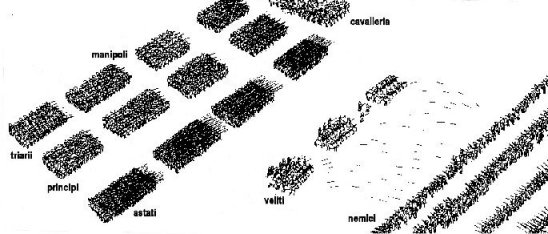
The number of the soldiers of every unity could vary and to be increased up to come around 5000-6000 men. During the punic wars the number of the enlisted legions increased. It dealt with a war that practically interested the whole basin of the Mediterranean, it is evident that Rome had to prepare 26 or 27 legions in the same year.
Gaio Mario's Reform^
In the first century BC, the consul Gaio Mario created a permanent army of volunteers and divided the legion in cohortes (a military unit composed of 600 men), these were stronger than the manipuli. The velite disappeared (replaced from auxiliary troops), that became infantryman as the others, and above all not there were more differences of armament among hastati, principes and triarii, but all became legionarii (legionary soldier).

The legionarii wore a wool tunic with sleeves short and long up to the knee, above they put a caress to strips and metallic flakes (lorica segmentata) that it protected the superior part of the body. In head they had the helmet (galea) and to the feet heavy leather sandals made of quite a lot layers of sole and studded of studs (caligae). The principal weapon offensive was the pilum or javelin. Every soldier had two of them. For the fight brought closer there was the gladius, short sword used of point and course on the right side. The left side was covered by the rectangular and convex scutum that offered the maximum protection to the body.
The reform of Mario also reduced the salmeries (impediment); every soldier brought everything with himself, even the material to camp himself: its burden weighed 30-40 kg.
The cavalry, was not more formed besides with italic elements, but it was drawn by auxiliary troops. The italic ones could enlist in the regular army, therefore the auxiliary troops (auxilia) were recruited in the provinces: the Roman cohorts were so placed side by side by Iberian slingers and riders from Gallia. The legion of Mario took sides on two lines of cohortes.
The assistants recruited in the provinces served in the military in bodies of 500-1000 men destined to sustain the first hostile bump. Thanks to their competences, the army earned in flexibility: the Siriacii, for example were skilled archers, the Tracii magnificent riders. To the dismissal, the assistants got the Roman citizen.
Giulio Cesare (59-44 BC) modified partly the line up bringing the cohors on three lines, four in first line and three in second and bystander line, these last ones you also use as reserves.
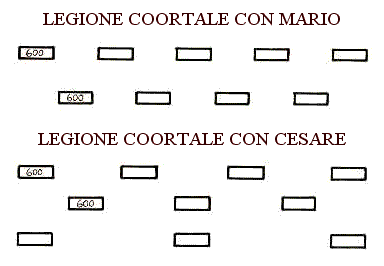 a comparison ...
a comparison ...The legion, made of cohorts, remained the predominant element of the Roman strength also during the principality and the imperial middle period. At the end of the republic, the army was constituted by 45 legions. Augusto (from 27 BC to 14 AD) reduced the legion to 25, but he placed the allied bodies, that furnished a contingent of infantry equal to that Roman and one of cavalry. The legions had a number and a name that it often identified the country where they had fought or where they were formed: for example the legio I italica was formed by Nerone with italic recruits. The expansion of the empire was such that around 100 AD the army was not for the most part composed from italic.
During Imperial Age^
In imperial age the army became permanent: it was a mercenary army enlisted for the 25 year-old duration, that was maintained and salaried, and it participated in the division of the loot of war.
 |
Every legion had for insignia a golden eagle with explained wings, brought on the top of a great auction by the aquilifer (ensign); there were also particular insignia for every body of the legion (cohors, manipulo or turma); therefore every legion had:
|
The constructions^
These jobs were not submitted to any people. It was the infantry, particularly that of the legions, that it furnished the manpower, while the cavalry assured the overseeing and the protection of the yard.
To quickly advance in hostile country, the general worried him about to be able to have easy streets to cross. The infantrymen provided to demolish the trees when a forest was crossed, to eliminate the bulky rocks and, in the lowland, to dry up even to the necessity swamps of small dimensions. They flattened the ground, or to the limit they had the signals that pointed out the direction to follow. These things were of primary importance to guarantee easy and fast restocking and communications.
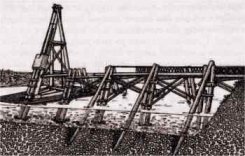
The crossing of the courses of water represented another difficulty: it needed to choose among three different solutions. Help could be asked to the harbor to cross the river in boat. Or, always with the help of the harbor, a bridge of boats was built. A real bridge could finally, be built, in wood or in stone (privileged choice because it offered the advantage of solidity and a street of escape, in this case the bridge was destroyed as soon as after the passage of the troops).
But the organizational quality went over: every evening, the legion had to be sheltered inside a camp. These provisional fields during the march, were temporary, built and destroyed daily and they differed from the permanent fields for dimensions and used materials. Before building a field, it needed to carefully choose the site. A ground in inclination was preferable: it favored the evacuation of the waters, the airing, and the exit in front of possible assailants made easier. The soldiers feared, for the relative brittleness of this type of construction, that was built in a few hours, the effect produced by an assault. The objective was to break the rush of the possible assailant, for this in front of the fortitude the legionarii dug some holes in which they put complete trunks of tree with their branches: these obstacles brought the name of "small bucks."
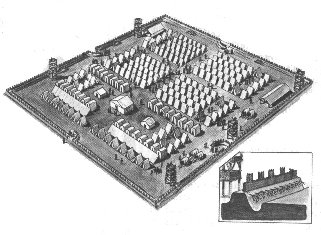
When this field is described, with the different jobs that the defense assures, with the extremely complex organization of its parts, and thinking that this whole structure was built every evening on a site new and destroyed every morning, it can be made to draw a conclusion: every officer had to perfectly know what its competences were, and every soldier had to know very well his own assignments. These demands implicated a recruitment of quality and a very inclined training.
Decline^
The legion of Augusto it lasted for about 150 years, with the only difference to make miliaria, that is of 1000 men around, the double one of the organic usual, the first court of every unity. The military reforms of Adriano (117-138 AD) and Settimio Severo (193-211 AD), also in their global vision of the problem, they didn't notch the essence of the legions, but they were of fundamental importance in other fields (pay, tactic, recruitment?).
From the period of Adriano the empire had the tendency only to defend the confinements, the senate and the ancient magistracies were for a long time without power, and it was for pure tradition that some emperors brought them formal respect. The Christianity, the impoverishment of the countries, the financial crises, the epidemics and the army, was finally the most evident elements that contributed to the fall of the central power.
The military apparatus was element of crisis with the continuous insurrections and the mutinies, but it was also the only mean to save the territorial unity of the empire.
Sources^
- Antonio Londrillo Viaggio nella storia 1, Milano, Mursia, 1992
- A. Saitta Civiltà del passato, Firenze, Sansoni, 1972
- AA. VV. La Civiltà greca romana-medievale, Milano, edizione CDE spa, 1968
- Tito Maccio Plauto Miles gloriosus, Milano, Rizzoli, 1991
- Antonio La Penna Primordia et incrementa latinitatis, Torino, Loescher, 1966
- L. Castiglioni, S. Mariotti IL, Torino, Loescher, 1990
Changelog^
- (26/11/1992) First version, original title of the scholastic search L'organizzazione militare di Roma
- (Summer 2001) Second version: revision, amplification and pagination for the web, title La Legione Romana
- (Summer 2005) revision, amplification and pagination for the web
- (Summer 2012) pagination for new CMS





